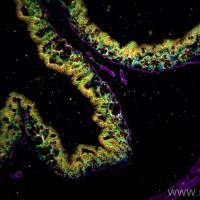Pulsed EPR Distance Measurements in Soluble Proteins by Site‐Directed Spin Labeling (SDSL)
互联网
- Abstract
- Table of Contents
- Materials
- Figures
- Literature Cited
Abstract
The resurgence of pulsed electron paramagnetic resonance (EPR) in structural biology centers on recent improvements in distance measurements using the double electron?electron resonance (DEER) technique. This unit focuses on EPR?based distance measurements by site?directed spin labeling (SDSL) of engineered cysteine residues in soluble proteins, with HIV?1 protease used as a model. To elucidate conformational changes in proteins, experimental protocols were optimized and existing data analysis programs were employed to derive distance?distribution profiles. Experimental considerations, sample preparation, and error analysis for artifact suppression are also outlined herein. Curr. Protoc. Protein Sci . 74:17.17.1?17.17.29. © 2013 by John Wiley & Sons, Inc.
Keywords: pulsed EPR; DEER; distance measurements; site?directed spin labeling
Table of Contents
- Introduction
- Nitroxide Spin Labels
- Selection of Labeling Sites
- Distance Measurement via DEER
- Basic Protocol 1: Site‐Directed Spin Labeling of Soluble Proteins
- Basic Protocol 2: Preparing DEER Samples
- Basic Protocol 3: Setting Up the EPR Spectrometer and Acquiring DEER Data
- Basic Protocol 4: Analysis of DEER Data
- Commentary
- Literature Cited
- Figures
Materials
Basic Protocol 1: Site‐Directed Spin Labeling of Soluble Proteins
Materials
Basic Protocol 2: Preparing DEER Samples
Materials
Basic Protocol 3: Setting Up the EPR Spectrometer and Acquiring DEER Data
Materials
Basic Protocol 4: Analysis of DEER Data
Materials
|
Figures
-
Figure 17.17.1 Chemical structures of four common nitroxide spin labels before and after reacting with a cysteine side chain. (A ,B ) MTSL: (1‐oxyl‐2,2,5,5‐tetramethyl‐Δ3‐pyrroline‐3‐methyl) methanethiosulfonate; (C ,D ) IAP: 3‐(2‐iodoacetamido)‐proxyl; (E ,F ) MSL: 4‐maleimido‐TEMPO; and (G and H) IASL: 4‐(2‐iodoacetamido)‐TEMPO. The rectangular box represents the protein backbone. View Image -
Figure 17.17.2 (A ) Four‐pulse DEER. Each pulse delay labeled with τ remains constant while spacing labeled with T is incremented. (B ) Pump and observe frequencies for nitroxide labels at X‐band. View Image -
Figure 17.17.3 Sample dipolar evolution curve before (gray solid line) and after (black solid line) applying the background subtraction function (blue dashed line). The red line is the regenerated echo curve from data analysis, which is discussed in . View Image -
Figure 17.17.4 Plots of the maximum spin concentration as a function of the inter‐spin distance. Solid line corresponds to the restriction imposed by instantaneous diffusion, while dashed line corresponds to the constraint imposed by intermolecular distances. View Image -
Figure 17.17.5 Sample preliminary experiments prior to DEER experiment setup. (A ) Field‐swept spectrum to determine center field; (B ) echo decay experiment to measure phase‐memory time, T m ; (C ) DEER echo acquisition to determine d0 and gate parameters; (D ) field‐swept echo‐detected spectrum to determine pump and observe frequencies. These data were collected at 65 K. View Image -
Figure 17.17.6 The four‐pulse DEER sequence with the pulse spacings labeled according to Bruker Xepr software package nomenclature. In reference to the four‐pulse DEER sequence in Figure , d1 = τ1 and d2 = τ2 (or τmax ). The time increment parameter dx is calculated as d2/ N , where N is the number of real data points. The start position of the echo signal is assigned as d0, while d3 is a critical delay parameter that prevents overlapping of the second observe pulse and pump pulse. View Image -
Figure 17.17.7 Schematic diagram of three methods utilized for obtaining distance information from the background‐subtracted dipolar evolution curve. View Image -
Figure 17.17.8 Example of an L‐curve (A ) and the corresponding distance profiles and dipolar modulation curves for low (B ,C ), optimal (D,E ), and high (F ,G ) regularization parameters (α). View Image -
Figure 17.17.9 Self‐consistent procedure for determining the appropriate level of background subtraction. View Image -
Figure 17.17.10 Effect of the breadth and most probable distance on the dipolar modulation curves. (A ) Varying FWHM of distance profiles centered at 36 Å; and (B ) the corresponding theoretical dipolar evolution curves with different decay rates. (C ) Profiles with different center distances but same FWHM and (D ) corresponding theoretical dipolar evolution curves with different oscillation frequencies. Inset highlights dipolar modulations that decay within the first 2 µsec. View Image -
Figure 17.17.11 The influence of τmax length on the corresponding distance profile. (A ) Gaussian distance profiles with most probable distance of 48 Å with FWHM of 1 Å (solid) and 7 Å (dashed). (B ) The corresponding theoretical dipolar evolution curves. Solid vertical line corresponds to τmax of 2 µsec (C ) The same dipolar evolution curves as in (B), but τmax is shortened to 2 µsec. (D ) The corresponding TKR distance profiles for (C), analyzed using DeerAnalysis software. View Image -
Figure 17.17.12 DEER data for Subtype B HIV‐1 protease acquired at variable τmax . (A ) Background‐subtracted dipolar evolution curves and the corresponding TKR fits (gray solid line). (B ) The corresponding TKR distance profiles. The vertical dashed line marks the position for a minor population centered at ∼40 Å. Data are vertically offset for clarity. View Image -
Figure 17.17.13 Intensity‐normalized T m curves and corresponding exponential decay fits for MTSL‐labeled HIV‐1 protease in 2 mM sodium acetate, pH 5.0, with H2 O and 30% glycerol (dotted line), 2 mM sodium acetate buffer pH 5.0 with H2 O and 30% deuterated glycerol (dashed line), 2 mM sodium acetate buffer pH 5.0 with D2 O and 30% deuterated glycerol (solid line). The oscillations in the deuterated solvents originate from ESEEM effects between the deuterons and spin labels. The vertical dashed line marks τ = 3 µsec. View Image -
Figure 17.17.14 DEER data processing for an HIV‐1 protease sample. (A ) Determination of zero time (xc ) by fitting a Gaussian function to the –300‐ to +300‐nsec region of the echo curve. (B ) Raw dipolar echo curve and the exponential decay function (red solid line) corresponding to a homogeneous three‐dimensional distribution that is employed for background subtraction. (C ) Long‐pass filtered and background‐subtracted dipolar modulation curve with Tikhonov regularization (TKR) fit (red solid line) overlaid with Gaussian‐reconstructed dipolar modulation (blue solid line). (D ) The L‐curves derived from TKR analysis that helps determine the optimal regularization parameter (α). (E ) TKR distance profile overlaid with the linear combination of Gaussian populations (red dashed line). Peaks labeled with asterisk indicate populations ≤5% that are not statistically significant at 95% confidence level based on the χ2 criterion. (F ) The Gaussian populations employed to regenerate the TKR distance profile. (G ) The Pake dipolar pattern that results from the Fourier transformation of the background‐subtracted dipolar modulation curve and the corresponding fit (red dashed line). (H ) Table of values for the most probable (center) distances, full width at half maxima (FWHM), and relative percentage of conformational populations (Pop. %) used for generating the Gaussian‐reconstructed distance profile in E (red dashed line). View Image
Videos
Literature Cited
| Literature Cited | |
| Altenbach, C., Oh, K.J., Trabanino, R.J., Hideg, K., and Hubbell, W.L. 2001. Estimation of inter‐residue distances in spin labeled proteins at physiological temperatures: Experimental strategies and practical limitations. Biochemistry 40:15471‐15482. | |
| Altenbach, C., Kusnetzow, A.K., Ernst, O.P., Hofmann, K.P., and Hubbell, W.L. 2008. High‐resolution distance mapping in rhodopsin reveals the pattern of helix movement due to activation. Proc. Natl. Acad. Sci. U.S.A. 105:7439‐7444. | |
| Bennati, M., Weber, A., Antonic, J., Perlstein, D.L., Robblee, J., and Stubbe, J. 2003. Pulsed ELDOR spectroscopy measures the distance between the two tyrosyl radicals in the R2 subunit of the E. coli ribonucleotide reductase. J. Am. Chem. Soc. 125:14988‐14989. | |
| Berliner, L.J., Eaton, S.S., and Eaton, G.E. 2000. Distance Measurements in Biological Systems by EPR. Kluwer Academic/Plenum Publishers, New York. | |
| Blackburn, M.E., Veloro, A.M., and Fanucci, G.E. 2009. Monitoring inhibitor‐induced conformational population shifts in HIV‐1 protease by pulsed EPR spectroscopy. Biochemistry 48:8765‐8767. | |
| Borbat, P.P., Crepeau, R.H., and Freed, J.H. 1997. Multifrequency two‐dimensional Fourier transform ESR: An X/Ku‐band spectrometer. J. Magn. Reson. 127:155‐167. | |
| Borbat, P.P., Mchaourab, H., and Freed, J.H. 2002. Protein structure determination using long‐distance constraints from double‐quantum coherence ESR: Study of T4 Lysozyme. Biophys. J. 82:360A‐360A. | |
| Borbat, P.P., Davis, J.H., Butcher, S.E., and Freed, J.H. 2004. Measurement of large distances in biomolecules using double‐quantum filtered refocused electron spin‐echoes. J. Am. Chem. Soc. 126:7746‐7747. | |
| Cai, Q., Kusnetzow, A.K., Hideg, K., Price, E.A., Haworth, I.S., and Qin, P.Z. 2007. Nanometer distance measurements in RNA using site‐directed spin labeling. Biophys. J. 93:2110‐2117. | |
| Chiang, Y.W., Borbat, P.P., and Freed, J.H. 2005. The determination of pair distance distributions by pulsed ESR using Tikhonov regularization. J. Magn. Reson. 172:279‐295. | |
| Cooke, J.A. and Brown, L.J. 2011. Distance measurements by continuous wave EPR spectroscopy to monitor protein folding. Methods Mol. Biol. 752:74‐96. | |
| Cornish, V.W., Benson, D.R., Altenbach, C.A., Hideg, K., Hubbell, W.L., and Schultz, P.G. 1994. Site‐specific incorporation of biophysical probes into proteins. Proc. Natl. Acad. Sci. U.S.A. 91:2910‐2914. | |
| Dastvan, R., Bode, B.E., Karuppiah, M.P., Marko, A., Lyubenova, S., Schwalbe, H., and Prisner, T.F. 2010. Optimization of transversal relaxation of nitroxides for pulsed electron‐electron double resonance spectroscopy in phospholipid membranes. J. Phys. Chem. B 114:13507‐13516. | |
| de Vera, I.M.S., Blackburn, M.E., and Fanucci, G.E. 2012. Correlating conformational shift induction with altered inhibitor potency in a multidrug resistant HIV‐1 protease variant. Biochemistry 51:7813‐7815. | |
| Durrant, J.D. and McCammon, J.A. 2011. Molecular dynamics simulations and drug discovery. BMC Biol. 9:71. | |
| Fajer, P.G. 1994. Determination of spin‐label orientation within the myosin head. Proc. Natl. Acad. Sci. U.S.A. 91:937‐941. | |
| Fajer, P. 2000. Electron spin resonance spectroscopy labeling in peptide and protein analysis. In Encyclopedia of Analytical Chemistry (R.A. Meyers, ed.) pp. 5725‐5761. John Wiley and Sons, New York. | |
| Fajer, P.G., Fajer, E.A., Brunsvold, N.J., and Thomas, D.D. 1988. Effects of AMPPNP on the orientation and rotational dynamics of spin‐labeled muscle cross‐bridges. Biophys. J. 53:513‐524. | |
| Fajer, P., Brown, L., and Song, L. 2006. Practical pulsed dipolar ESR (DEER). Spin Label. 1:95‐128. | |
| Fanucci, G.E., Lee, J.Y., and Cafiso, D.S. 2003. Spectroscopic evidence that osmolytes in crystallization buffers inhibit a conformational change in a membrane protein. Biochemistry 42:13106‐13222. | |
| Fanucci, G.E. and Cafiso, D.S. 2006. Recent advances and applications of site‐directed spin labeling. Curr. Opin. Struct. Biol. 16:644‐653. | |
| Fawzi, N.L., Fleissner, M.R., Anthis, N.J., Kalai, T., Hideg, K., Hubbell, W.L., and Clore, G.M. 2011. A rigid disulfide‐linked nitroxide side chain simplifies the quantitative analysis of PRE data. J. Biomol. NMR 51:105‐114. | |
| Fleissner, M.R., Brustad, E.M., Kalai, T., Altenbach, C., Cascio, D., Peters, F.B., Hideg, K., Peuker, S., Schultz, P.G., and Hubbell, W.L. 2009. Site‐directed spin labeling of a genetically encoded unnatural amino acid. Proc. Natl. Acad. Sci. U.S.A. 106:21637‐21642. | |
| Fleissner, M.R., Bridges, M.D., Brooks, E.K., Cascio, D., Kalai, T., Hideg, K., and Hubbell, W.L. 2011. Structure and dynamics of a conformationally constrained nitroxide side chain and applications in EPR spectroscopy. Proc. Natl. Acad. Sci. U.S.A. 108:16241‐16246. | |
| Gabrys, C.M., Yang, J., and Weliky, D.P. 2003. Analysis of local conformation of membrane‐bound and polycrystalline peptides by two‐dimensional slow‐spinning rotor‐synchronized MAS exchange spectroscopy. J. Biomol. NMR 26:49‐68. | |
| Galiano, L., Blackburn, M.E., Veloro, A.M., Bonora, M., and Fanucci, G.E. 2009a. Solute effects on spin labels at an aqueous‐exposed site in the flap region of HIV‐1 protease. J. Phys. Chem. B 113:1673‐1680. | |
| Galiano, L., Ding, F., Veloro, A.M., Blackburn, M.E., Simmerling, C., and Fanucci, G.E. 2009b. Drug pressure selected mutations in HIV‐1 protease alter flap conformations. J. Am. Chem. Soc. 131:430‐431. | |
| Gekko, K. and Timasheff, S.N. 1981. Mechanism of protein stabilization by glycerol: Preferential hydration in glycerol‐water mixtures. Biochemistry 20:4667‐4676. | |
| Georgieva, E.R., Roy, A.S., Grigoryants, V.M., Borbat, P.P., Earle, K.A., Scholes, C.P., and Freed, J.H. 2012. Effect of freezing conditions on distances and their distributions derived from double electron electron resonance (DEER): A study of doubly‐spin‐labeled T4 lysozyme. J. Magn. Reson. 216:69‐77. | |
| Getz, E.B., Xiao, M., Chakrabarty, T., Cooke, R., and Selvin, P.R. 1999. A comparison between the sulfhydryl reductants tris(2‐carboxyethyl)phosphine and dithiothreitol for use in protein biochemistry. Anal. Biochem. 273:73‐80. | |
| Ghimire, H., McCarrick, R.M., Budil, D.E., and Lorigan, G.A. 2009. Significantly improved sensitivity of Q‐band PELDOR/DEER experiments relative to X‐band is observed in measuring the intercoil distance of a leucine zipper motif peptide (GCN4‐LZ). Biochemistry 48:5782‐5784. | |
| Han, J.C. and Han, G.Y. 1994. A procedure for quantitative determination of tris(2‐carboxyethyl)phosphine, an odorless reducing agent more stable and effective than dithiothreitol. Anal. Biochem. 220:5‐10. | |
| Hanson, P., Anderson, D.J., Martinez, G., Millhauser, G., Formaggio, F., Crisma, M., Toniolo, C., and Vita, C. 1998. Electron spin resonance and structural analysis of water soluble, alanine‐rich peptides incorporating TOAC. Mol. Phys. 95:957‐966. | |
| Hubbell, W.L., Gross, A., Langen, R., and Lietzow, M.A. 1998. Recent advances in site‐directed spin labeling of proteins. Curr. Opin. Struct. Biol. 8:649‐656. | |
| Huber, M., Lindgren, M., Hammarstrom, P., Martensson, L.G., Carlsson, U., Eaton, G.R., and Eaton, S.S. 2001. Phase memory relaxation times of spin labels in human carbonic anhydrase II: Pulsed EPR to determine spin label location. Biophys. Chem. 94:245‐256. | |
| Huyghues‐Despointes, B.M., Pace, C.N., Englander, S.W., and Scholtz, J.M. 2001. Measuring the conformational stability of a protein by hydrogen exchange. Methods Mol. Biol. 168:69‐92. | |
| Jeschke, G. 2002. Distance measurements in the nanometer range by pulse EPR. ChemPhysChem 3:927‐932. | |
| Jeschke, G. 2012. DEER distance measurements on proteins. Annu. Rev. Phys. Chem. 63:419‐446. | |
| Jeschke, G. and Polyhach, Y. 2007. Distance measurements on spin‐labelled biomacromolecules by pulsed electron paramagnetic resonance. Phys. Chem. Chem. Phys. 9:1895‐1910. | |
| Jeschke, G., Bender, A., Paulsen, H., Zimmermann, H., and Godt, A. 2004a. Sensitivity enhancement in pulse EPR distance measurements. J. Magn. Reson. 169:1‐12. | |
| Jeschke, G., Panek, G., Godt, A., Bender, A., and Paulsen, H. 2004b. Data analysis procedures for pulse ELDOR measurements of broad distance distributions. Appl. Magn. Reson. 26:223‐244. | |
| Jeschke, G., Wegener, C., Nietschke, M., Jung, H., and Steinhoff, H.J. 2004c. Interresidual distance determination by four‐pulse double electron‐electron resonance in an integral membrane protein: The Na+/proline transporter PutP of Escherichia coli. Biophys. J. 86:2551‐2557. | |
| Jeschke, G., Chechik, V., Ionita, P., Godt, A., Zimmermann, H., Banham, J., Timmel, C.R., Hilger, D., and Jung, H. 2006. DeerAnalysis2006—A comprehensive software package for analyzing pulsed ELDOR data. Appl. Magn. Reson. 30:473‐498. | |
| Kear, J.L., Blackburn, M.E., Veloro, A.M., Dunn, B.M., and Fanucci, G.E. 2009. Subtype polymorphisms among HIV‐1 protease variants confer altered flap conformations and flexibility. J. Am. Chem. Soc. 131:14650‐14651. | |
| Kim, M., Xu, Q., Fanucci, G.E., and Cafiso, D.S. 2006. Solutes modify a conformational transition in a membrane transport protein. Biophys. J. 90:2922‐2929. | |
| Kim, N.K., Bowman, M.K., and DeRose, V.J. 2010. Precise mapping of RNA tertiary structure via nanometer distance measurements with double electron‐electron resonance spectroscopy. J. Am. Chem. Soc. 132:8882‐8884. | |
| Kuttner, Y.Y., Kozer, N., Segal, E., Schreiber, G., and Haran, G. 2005. Separating the contribution of translational and rotational diffusion to protein association. J. Am. Chem. Soc. 127:15138‐15144. | |
| Lavalette, D., Hink, M.A., Tourbez, M., Tetreau, C., and Visser, A.J. 2006. Proteins as micro viscosimeters: Brownian motion revisited. Eur. Biophys. J. 35:517‐522. | |
| Lee, J.C. and Timasheff, S.N. 1981. The stabilization of proteins by sucrose. J. Biol. Chem. 256:7193‐7201. | |
| López C.J., Fleissner, M.R., Guo, Z., Kismetzpw, A.K., and Hubbell, W.L. 2009. Osmolyte perturbation reveals conformational equilibria in spin‐labeled proteins. Prot. Sci. 18:1637‐1652. | |
| Lovett, J.E., Bowen, A.M., Timmel, C.R., Jones, M.W., Dilworth, J.R., Caprotti, D., Bell, S.G., Wong, L.L., and Harmer, J. 2009. Structural information from orientationally selective DEER spectroscopy. Phys. Chem. Chem. Phys. 11:6840‐6848. | |
| Mao, Q., Schleidt, S., Zimmermann, H., and Jeschke, G. 2008. A pulsed EPR study of surfactant layer structure in composites of a synthetic layered silicate with polystyrene and polycaprolactone. Phys. Chem. Chem. Phys. 10:1156‐1167. | |
| McHaourab, H.S., Oh, K.J., Fang, C.J., and Hubbell, W.L. 1997. Conformation of T4 lysozyme in solution. Hinge‐bending motion and the substrate‐induced conformational transition studied by site‐directed spin labeling. Biochemistry 36:307‐316. | |
| Mchaourab, H.S., Steed, P.R., and Kazmier, K. 2011. Toward the fourth dimension of membrane protein structure: Insight into dynamics from spin‐labeling EPR spectroscopy. Structure 19:1549‐1561. | |
| Miick, S.M., Martinez, G.V., Fiori, W.R., Todd, A.P., and Millhauser, G.L. 1992. Short alanine‐based peptides may form 3(10)‐helices and not alpha‐helices in aqueous solution. Nature 359:653‐655. | |
| Milov, A.D., Maryasov, A.G., Tsvetkov, Y.D., and Raap, J. 1999. Pulsed ELDOR in spin‐labeled polypeptides. Chem. Phys. Lett. 303:135‐143. | |
| Misra, S.K., Borbat, P.P., and Freed, J.H. 2009. Calculation of double‐quantum‐coherence two‐dimensional spectra: Distance measurements and orientational correlations. Appl. Magn. Reson. 36:237‐258. | |
| Narr, E., Godt, A., and Jeschke, G. 2002. Selective measurements of a nitroxide‐nitroxide separation of 5 nm and a nitroxide‐copper separation of 2.5 nm in a terpyridine‐based copper(II) complex by pulse EPR spectroscopy. Angew. Chem. Int. Ed. Engl. 41:3907‐3910. | |
| Pannier, M., Veit, S., Godt, A., Jeschke, G., and Spiess, H.W. 2000. Dead‐time free measurement of dipole‐dipole interactions between electron spins. J. Magn. Reson. 142:331‐340. | |
| Persson, M., Harbridge, J.R., Hammarstrom, P., Mitri, R., Martensson, L.G., Carlsson, U., Eaton, G.R., and Eaton, S.S. 2001. Comparison of electron paramagnetic resonance methods to determine distances between spin labels on human carbonic anhydrase II. Biophys. J. 80:2886‐2897. | |
| Pistolesi, S., Pogni, R., and Feix, J.B. 2007. Membrane insertion and bilayer perturbation by antimicrobial peptide CM15. Biophys. J. 93:1651‐1660. | |
| Polyhach, Y. and Jeschke, G. 2010. Prediction of favourable sites for spin labelling of proteins. Spectroscopy 24:651‐659. | |
| Polyhach, Y., Bordignon, E., and Jeschke, G. 2011. Rotamer libraries of spin labelled cysteines for protein studies. Phys. Chem. Chem. Phys. 13:2356‐2366. | |
| Polyhach, Y., Bordignon, E., Tschaggelar, R., Gandra, S., Godt, A., and Jeschke, G. 2012. High sensitivity and versatility of the DEER experiment on nitroxide radical pairs at Q‐band frequencies. Phys. Chem. Chem. Phys. 14:10762‐10773. | |
| Potapov, A., Yagi, H., Huber, T., Jergic, S., Dixon, N.E., Otting, G., and Goldfarb, D. 2010. Nanometer‐scale distance measurements in proteins using Gd3+ spin labeling. J. Am. Chem. Soc. 132:9040‐9048. | |
| Prisner, T., Rohrer, M., and MacMillan, F. 2001. Pulsed EPR spectroscopy: Biological applications. Annu. Rev. Phys. Chem. 52:279‐313. | |
| Rabenstein, M.D. and Shin, Y.K. 1995. Determination of the distance between two spin labels attached to a macromolecule. Proc. Natl. Acad. Sci. U.S.A. 92:8239‐8243. | |
| Raitsimring, A.M., Gunanathan, C., Potapov, A., Efremenko, I., Martin, J.M., Milstein, D., and Goldfarb, D. 2007. Gd3+ complexes as potential spin labels for high field pulsed EPR distance measurements. J. Am. Chem. Soc. 129:14138‐14139. | |
| Riplinger, C., Kao, J.P., Rosen, G.M., Kathirvelu, V., Eaton, G.R., Eaton, S.S., Kutateladze, A., and Neese, F. 2009. Interaction of radical pairs through‐bond and through‐space: scope and limitations of the point‐dipole approximation in electron paramagnetic resonance spectroscopy. J. Am. Chem. Soc. 131:10092‐10106. | |
| Roessler, M.M., King, M.S., Robinson, A.J., Armstrong, F.A., Harmer, J., and Hirst, J. 2010. Direct assignment of EPR spectra to structurally defined iron‐sulfur clusters in complex I by double electron‐electron resonance. Proc. Natl. Acad. Sci. U.S.A. 107:1930‐1935. | |
| Roopnarine, O. and Thomas, D.D. 1994. A spin label that binds to myosin heads in muscle fibers with its principal axis parallel to the fiber axis. Biophys. J. 67:1634‐1645. | |
| Schiemann, O., Cekan, P., Margraf, D., Prisner, T.F., and Sigurdsson, S.T. 2009. Relative orientation of rigid nitroxides by PELDOR: Beyond distance measurements in nucleic acids. Angew. Chem. Int. Ed. 48:3292‐3295. | |
| Schreier, S., Bozelli, J.C., Jr., Marin, N., Vieira, R.F., and Nakaie, C.R. 2012. The spin label amino acid TOAC and its uses in studies of peptides: Chemical, physicochemical, spectroscopic, and conformational aspects. Biophys. Rev. 4:45‐66. | |
| Sen, K.I., Logan, T.M., and Fajer, P.G. 2007. Protein dynamics and monomer‐monomer interactions in AntR activation by electron paramagnetic resonance and double electron‐electron resonance. Biochemistry 46:11639‐11649. | |
| Song, Y., Meade, T.J., Astashkin, A.V., Klein, E.L., Enemark, J.H., and Raitsimring, A. 2011. Pulsed dipolar spectroscopy distance measurements in biomacromolecules labeled with Gd(III) markers. J. Magn. Reson. 210:59‐68. | |
| Suarez, J., Ranguelova, K., Jarzecki, A.A., Manzerova, J., Krymov, V., Zhao, X., Yu, S., Metlitsky, L., Gerfen, G.J., and Magliozzo, R.S. 2009. An oxyferrous heme/protein‐based radical intermediate is catalytically competent in the catalase reaction of Mycobacterium tuberculosis catalase‐peroxidase (KatG). J. Biol. Chem. 284:7017‐7029. | |
| Thomas, D.D. and Cooke, R. 1980. Orientation of spin‐labeled myosin heads in glycerinated muscle fibers. Biophys. J. 32:891‐906. | |
| Thomas, D.D., Ishiwata, S., Seidel, J.C., and Gergely, J. 1980. Submillisecond rotational dynamics of spin‐labeled myosin heads in myofibrils. Biophys. J. 32:873‐889. | |
| Timasheff, S.N. 2002. Protein hydration, thermodynamic binding, and preferential hydration. Biochemistry 41:13473‐13482. | |
| Tsvetkov, Y.D. and Grishin, Y.A. 2009. Techniques for EPR spectroscopy of pulsed electron double resonance (PELDOR): A review. Instrum. Exp. Techn. 52:615‐636. | |
| Volkov, A., Dockter, C., Bund, T., Paulsen, H., and Jeschke, G. 2009. Pulsed EPR determination of water accessibility to spin‐labeled amino acid residues in LHCIIb. Biophys. J. 96:1124‐1141. | |
| Ward, R., Bowman, A., El‐Mkami, H., Owen‐Hughes, T., and Norman, D.G. 2009. Long distance PELDOR measurements on the histone core particle. J. Am. Chem. Soc. 131:1348‐1349. | |
| Ward, R., Bowman, A., Sozudogru, E., El‐Mkami, H., Owen‐Hughes, T., and Norman, D.G. 2010. EPR distance measurements in deuterated proteins. J. Magn. Reson. 207:164‐167. | |
| Waring, A.J. and Cooke, R. 1987. The molecular dynamics of actin measured by a spin probe attached to lysine. Arch. Biochem. Biophys. 252:197‐205. | |
| Yang, Z., Becker, J., and Saxena, S. 2007. On Cu(II)‐Cu(II) distance measurements using pulsed electron electron double resonance. J. Magn. Reson. 188:337‐343. | |
| Yang, Z., Kise, D., and Saxena, S. 2010. An approach towards the measurement of nanometer range distances based on Cu2+ ions and ESR. J. Phys. Chem. B 114:6165‐6174. | |
| Yang, Z., Liu, Y., Borbat, P., Zweier, J.L., Freed, J.H., and Hubbell, W.L. 2012. Pulsed ESR dipolar spectroscopy for distance measurements in immobilized spin labeled proteins in liquid solution. J. Am. Chem. Soc. 134:9950‐9952. | |
| Zou, P. and McHaourab, H.S. 2010. Increased sensitivity and extended range of distance measurements in spin‐labeled membrane proteins: Q‐band double electron‐electron resonance and nanoscale bilayers. Biophys. J. 98:L18‐L20. |









